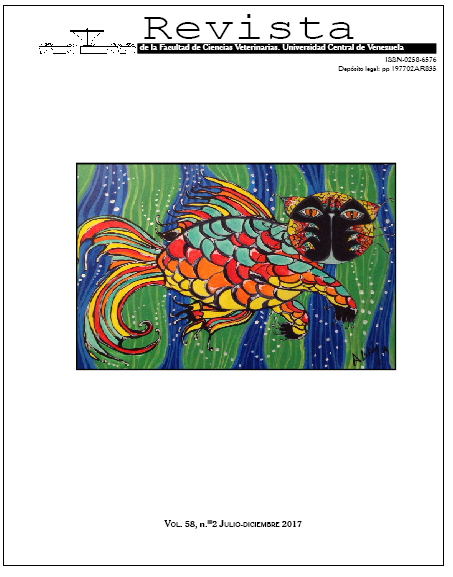Hallazgos Histopatológicos en Piel de Caninos Naturalmente Infectados con Leishmania infantum, Municipio Bolívar, Estado Aragua
Contenido principal del artículo
Resumen
La Leishmaniasis es una enfermedad metaxénica, de distribución mundial, producida por diversas especies de protozoarios del género Leishmania, transmitida por vectores del género Lutzomyia. Clasificada en cutánea, muco cutánea y visceral, Leishmania infantum es la especie causante del patrón visceral y el canino (Canis familiaris) es su principal reservorio. El tropismo de L. infantum induce la sintomatología y el daño tisular en la leishmaniasis visceral canina (LVC), la cual cursa con la triada sintomatológica (fiebre alta, hepatoesplenomegalia y leucopenia, seguida de pancitopenia), provoca daños locales en el sitio de inoculación, por la interacción parásito-macrófagos regionales y manifestaciones dermatológicas inespecíficas, clínicamente ubicadas dentro de los patrones: asintomáticos, oligosintomáticos y polisintomáticos de la enfermedad. De 14 caninos seropositivos a L. infantum (usando el antígeno rK39), procedentes del municipio Bolívar del estado Aragua, localidades Topo I, Topo II y Las Cumbres de Zamora, a 7 aninales se les tomaron 3 muestras de piel de 10 puntos anatómicos para el estudio histopatológico. Los cortes histológicos para el estudio microscópico, se obtuvieron mediante el empleo de técnicas histológicas de rutina, con la coloración de Hematoxilina- Eosina. Como consecuencia de la infección, se generaron anticuerpos. Clínicamente los animales mostraron patrones asintomáticos u oligosintomáticos, con lesiones inespecíficas en diversas regiones anatómicas. No se evidenciaron cambios celulares; sin embargo, en epidermis se apreciaron zonas con hiperqueratosis, acantosis, e infiltrado neutrofílico en glándulas sudoríparas y sebáceas; en dermis se observó, infiltrado inflamatorio linfohistioplasmocitario y edema intersticial o interfibrilar, en hipodermis se observó neovascularización e inflamación linfoplasmocitaria periductal. No se evidenciaron amastigotes en células fagocíticas.
Histopatological Findings in Natural Infected Dogs with Leishmania Infantum, Bolivar Country, Aragua State
Abstract
Leishmaniasis is a metaxenic disease, worldwide distributed. This disease is produced by several species of protozoa of the genus Leishmania and is transmitted by vectors (sandflies) of the genus Lutzomyia. Leishmaniasis has been classified in cutaneous, muco-cutaneous, and visceral. Leishmania infantum is the species responsible for the visceral pattern and the canine (Canis familiaris) is the main reservoir. The tropism of L. infantum induces the symptomatology and the tissue damage in canine visceral leishmaniasis, which is characterized by the symptomatic triad of high fever, hepato-splenomegaly and leucopenia, followed by pancitopenia. This disease causes local damage at the site of inoculation due to the interaction between the parasite and the regional macrophages and to nonspecific dermatological manifestations, clinically located within the asymptomatic, oligosymptomatic, and polysymptomatic patterns of the disease. In this investigation, a total of 14 canines from Topo I, Topo II, and Las Cumbres de Zamora, from the Bolívar municipality of the State of Aragua, Venezuela, showed seropositivity to L. infantum (using the rK39 antigen). To perform the histopathological study, 7 of them were taken 3 skin samples of 10 anatomical points. The histological sections for the microscopic study were obtained using the hematoxilin-esosin technique. As a result of the infection, antibodies were generated. From the clinical standpoint, the animals showed asymptomatic or oligosymptomatic patterns, with nonspecific lesions in diverse anatomical regions. No cellular changes were evident; however, in the epidermis, areas with hyperkeratosis, acanthosis, and neutrophilic infiltrate were observed in sweat and sebaceous glands; in the dermis, a lymphohistioplasmocytic inflammatory infiltrate and interstitial or interfibrillar edema was detected; in the hypodermis, neovascularization and periductal lymphoplasmatic inflammation was noted. No amastigotes were evident in phagocytic cells.
